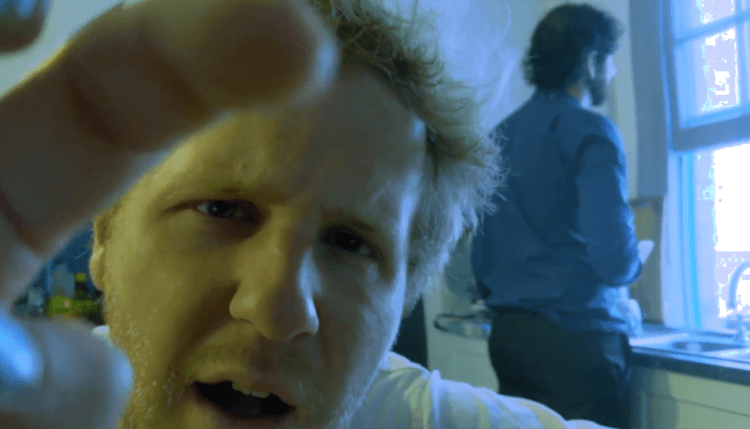
Eamon, Eva, Rory, Liam

It is said a fish’s memory resets with every lap of its bowl…
Fish Tank, created by Eamon, Eva, Rory and Liam is a film made up of four scenes that can be viewed individually or as part of a sequential whole. The audience engages with characters Casey and Matt holding a funeral for fish Bung, through each directors individual style.
SCENE 1
The first sequence is a straight interpretation of an utterly surreal script. I took some small liberties in cutaways in an effort to draw attention to actions that would increase the abstract atmosphere of the scene, but the action and dialogue is completely faithful to the screenplay. I adored the dreamlike aura of the script and aimed to create a film sequence that felt like it took place in an elevated reality.
Fish Tank posed a few technical challenges that were beneficial to overcome, including masking and tracking, sound design and achieving the particular colour grade I had in mind. These, plus the standard tasks involved in a film shoot across all four sequences have ingrained a great deal of experience for such a small project. I look forward to compiling the four finished sequences and I am excited to share what we’ve been working towards.
-Rory Ashleigh
SCENE 2
This version of Fish Tank directed by me, Eva Massey, tells the familiar story of Bung’s funeral with characters Carey and Ash communicating over the internet. I chose to tell the narrative in this way, after observing the humour and unease we have found ourselves in for the last two years studying, partying, getting married and even attending funerals over applications like Zoom.
Through many experiments and collaborations, making Fish Tank has allowed me to develop as a deliberate film maker. It has reinforced my passion for directing and strengthened my skills in editing and framing, specifically regarding the challenges of masking the laptop screen and colour grading. Working on Fish Tank has also improved my collaborative skills, and I am excited for you to see the hard work of actors Casey and Matt, and Rory’s camera operation!
– Eva Massey
SCENE 3
The direction which I took was a reimagining of the “Fish Tank” script from the limited perspective of Bung, the goldfish who, despite being central to the themes and story of the script, is otherwise an extremely minor character. By choosing to shift the perspective of the story, my piece was then guided by the constraints of a POV style, which drastically altered the production and post-production process, shot types and style of the film, in keeping with the idea of a first-person narrative. My whole sequence is filmed in this style, which effectively removed the need for any B-roll or overlay, so as to immerse viewers in Bung’s situation.
Within the series of films that my group produced, my version of Fish Tank will be screened third. The change in perspective signifies a sudden departure from the more traditional approaches taken by Rory and Eva, before the audience’s increasingly strange journey ends at Liam’s experimental piece.
– Eamon O’Callaghan
SCENE 4
This final interpretation of our narrative continues the film’s delve into obscurity and experimentation by presenting these repeated scenarios in their most abstract and offbeat form. Scene 4 of our feature leans further into visual storytelling through a reduction and deliberate incoherence to the dialogue from previous scenes, as well as a dive into the dream-like atmosphere and tone developed through the previous parts, shown here through the calming visions of nature followed by the frenetic and nightmarish closure to the piece. These two distinct pieces are separated largely by the differing editing styles presented, with the dissolves and light tones of the first half turning to hard cuts and jarring colours, moving from a delicate soothing sense of pause to a dreaded sensory overload.
Being tasked with the final scene allowed me to build off the previous work of my group, having their visions and ideas both influence my final part, as well as directly feature within Scene 4. Only because of the structure set in how they formed and created their versions of the ‘Fish Bowl’ story was I given the freedom to take my final work into the abstract territory that I wanted.
-Liam Shields